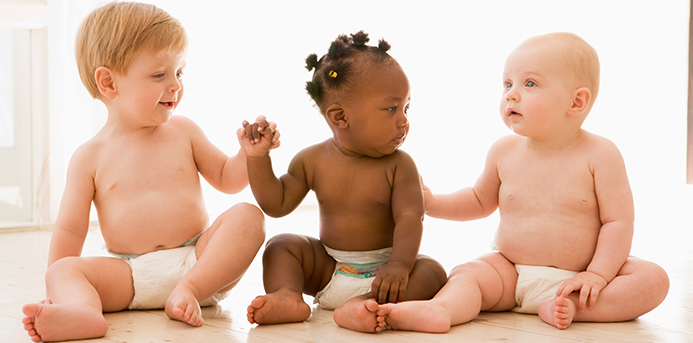If you have children in diapers, the seemingly endless diaper changes are probably not your favorite parts of the day. But, those moments — which so many of us take for granted as one of the necessary evils of parenting — are wrought with anxiety for many parents who can’t afford enough diapers for their babies.
Even if diapers are well within your household budget, you’ve surely lamented the cost at one point or another. The average child goes through six to 10 diapers a day. Multiply that by the two to three years before most children are potty trained, and you have a significant expense. According to the National Diaper Bank Network (NDBN), families spend $70-$80 a month on diapers for each child. And, a startling 1 in 3 moms in the U.S. report some level of diaper need.
“Most people who don’t experience poverty don’t understand what concrete poverty in America looks like,” says Joanne Goldblum, executive director of NDBN. “Diapers are a valuable window into that because it is something that is so easy for us all to understand — how hard it would be not to have enough diapers for your child.”
Not being able to afford diapers creates an immediate and serious problem for families. Babies who aren’t changed often enough because parents are trying to conserve diapers can develop painful rashes and urinary tract infections, trying to get rid of UTI in babies can be difficult. Not being able to provide for their child’s basic needs can cause stress and shame for parents, and can contribute to postpartum depression. In the worst cases, babies left in soiled diapers cry for long periods of time, increasing the risk of abuse by stressed, exhausted parents.
Most childcare centers, even free and subsidized facilities, require babies to be dropped off with a full day’s supply of disposable diapers, according to NDBN. So, low-income parents struggling to afford diapers may not be able to go to work because they can’t take their children to daycare.
Debbie Aglietti is the co-founder of No Child Wet Behind, a nonprofit that helps doulas around the country organize diaper drives in their own communities. Aglietti says parents who have access to a computer, a credit card, a car and a permanent mailing address can purchase discounted diapers in bulk quantities online or at big-box stores like Target. Meanwhile, low-income families have to resort to buying small packages of diapers at convenience stores — often for twice the price you’d find on Amazon or at Costco — simply because they don’t have the means to shop at those places.
What about cloth diapers? That’s the question many people ask when first learning about diaper need. However, Aglietti says cloth diapers usually aren’t a viable solution because many low-income families don’t have in-home washing machines, and laundromats don’t permit customers to wash soiled diapers in their facilities. Even more surprising to people who have never struggled to afford diapers is that they cannot be purchased with food stamps, Link cards or WIC vouchers.
“You can buy lobster with food stamps, but you can’t buy diapers,” Aglietti says.
Goldblum says work is being done at the national legislative level to explore ways to get diapers to the families that need them. In the meantime, nonprofit diaper banks are bridging the gap. NBDN supports 275 diaper banks around the country that distributed 35 million free diapers in 2014, including 20 million donated by Huggies.
One of the organizations working to end Chicago-area diaper need is Evanston-based Bundled Blessings. The group collects or purchases about 12,000 diapers per month and partners with seven local social service agencies that distribute the diapers to families in need.
Helen Hurry is a family advocate worker at Family Focus in Evanston, which is one of the recipients of diapers from Bundled Blessings. Hurry says most of the people who come to her agency for diapers are living at or below the poverty line, and having access to donated diapers makes a big difference in their lives.
“I had one participant who came in crying because she felt ashamed to ask for diapers,” Hurry says. “But, she stated to me that her husband’s hours were cut, and as a result, they had two children in diapers and limited funds.”
If you’d like to help Bundled Blessings reach their goal of keeping 250-260 local babies in clean diapers, program co-chair Krys Juleen says you can drop off diapers in one of the drop-off barrels located in Evanston, Winnetka and Lake Forest, or you can work with Bundled Blessing to host a diaper drive. Juleen says monetary donations are also welcome, and 100 percent of funds are used to purchase diapers.
“Most of the agencies we deal with are always in need of more diapers,” Juleen says.
Most diaper banks, including Bundled Blessings, don’t receive enough donated diapers to meet the monthly needs of the agencies they serve, so they supplement by purchasing diapers. To help meet that need, online retailer Jet.com recently partnered with Cuties brand to sell diapers to nonprofits at a deep discount, in response to a call to action by the Obama administration.
“When we learned about the diaper gap from the White House, we knew this was a problem that we were compelled to try to address,” says Dana Hork, director of brand experience for Jet.com. “We worked with Cuties to develop a [product] SKU to pull out excess costs, like building a bigger box and removing expensive graphics.”
Jet.com now has 800 nonprofits enrolled in its Community Diaper Program. Individual consumers can purchase diapers for an average cost of 17 cents per diaper on Jet.com, and Hork says nonprofits receive an additional 25 percent discount.
More from Make It Better:

